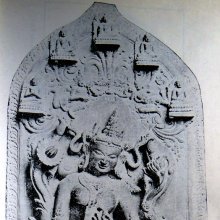Mahashritara, Mahāśrītārā, Mahashri-tara: 1 definition
Introduction:
Mahashritara means something in Buddhism, Pali. If you want to know the exact meaning, history, etymology or English translation of this term then check out the descriptions on this page. Add your comment or reference to a book if you want to contribute to this summary article.
The Sanskrit term Mahāśrītārā can be transliterated into English as Mahasritara or Mahashritara, using the IAST transliteration scheme (?).
Images (photo gallery)
In Buddhism
Tibetan Buddhism (Vajrayana or tantric Buddhism)
Source: archive.org: The Indian Buddhist IconographyMahāśrītārā (महाश्रीतारा) or simply Mahāśrī (lit. “saviouress of great beauty”) refers to one of the various emanations of Amoghasiddhi, as mentioned in the 5th-century Sādhanamālā (a collection of sādhana texts that contain detailed instructions for rituals).—Her Colour: green; her Mudrā is the vyākhyāna; she has two arms and four companions.

Tibetan Buddhism includes schools such as Nyingma, Kadampa, Kagyu and Gelug. Their primary canon of literature is divided in two broad categories: The Kangyur, which consists of Buddha’s words, and the Tengyur, which includes commentaries from various sources. Esotericism and tantra techniques (vajrayāna) are collected indepently.
See also (Relevant definitions)
Partial matches: Mahasri, Tara.
Full-text: Varadatara, Varada, Mahasri.
Relevant text
Search found 1 books and stories containing Mahashritara, Mahāśrītārā, Mahashri-tara, Mahāśrī-tārā, Mahasritara, Mahasri-tara; (plurals include: Mahashritaras, Mahāśrītārās, taras, tārās, Mahasritaras). You can also click to the full overview containing English textual excerpts. Below are direct links for the most relevant articles:
The Indian Buddhist Iconography (by Benoytosh Bhattachacharyya)
